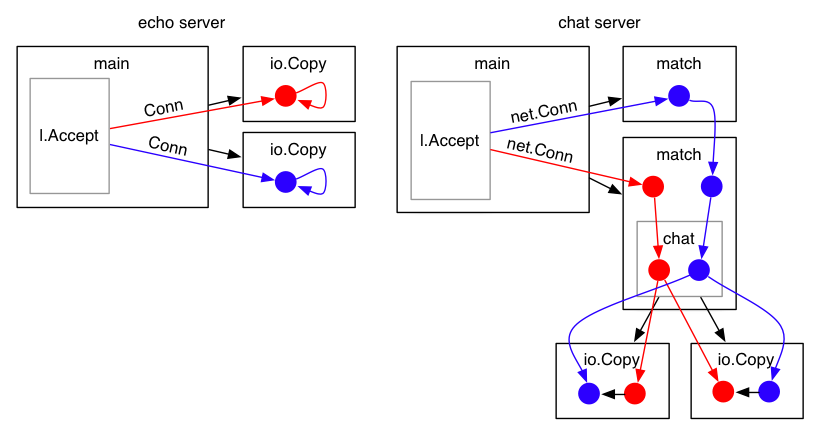Go: code that grows with grace
Andrew Gerrand
Google Sydney
Andrew Gerrand
Google Sydney
A video of this talk was recorded at Øredev in Malmö, Sweden in November 2012.
2You may have heard of Go.
It's my favorite language. I think you'll like it, too.
3An open source (BSD licensed) project:
gc and gccgo),As of September 2012 we have more than 300 contributors.
4Go is Object Oriented, but not in the usual way.
The result: simple pieces connected by small interfaces.
5Go provides CSP-like concurrency primitives.
The result: comprehensible concurrent code.
6
Go is about composition, concurrency, and gophers.
Keep that in mind.
8package main import "fmt" func main() { fmt.Println("Hello, go") }
package main import ( "fmt" "log" "net" ) const listenAddr = "localhost:4000" func main() { l, err := net.Listen("tcp", listenAddr) if err != nil { log.Fatal(err) } for { c, err := l.Accept() if err != nil { log.Fatal(err) } fmt.Fprintln(c, "Hello!") c.Close() } }
Hey neato! We just used Fprintln to write to a net connection.
That's because a Fprintln writes to an io.Writer, and net.Conn is an io.Writer.
fmt.Fprintln(c, "Hello!")
func Fprintln(w io.Writer, a ...interface{}) (n int, err error)
type Writer interface { Write(p []byte) (n int, err error) }
type Conn interface { Read(b []byte) (n int, err error) Write(b []byte) (n int, err error) Close() error // ... some additional methods omitted ... }
package main import ( "io" "log" "net" ) const listenAddr = "localhost:4000" func main() { l, err := net.Listen("tcp", listenAddr) if err != nil { log.Fatal(err) } for { c, err := l.Accept() if err != nil { log.Fatal(err) } io.Copy(c, c) } }
io.Copy(c, c)
// Copy copies from src to dst until either EOF is reached // on src or an error occurs. It returns the number of bytes // copied and the first error encountered while copying, if any. func Copy(dst Writer, src Reader) (written int64, err error)
type Conn interface { Read(b []byte) (n int, err error) Write(b []byte) (n int, err error) Close() error // ... some additional methods omitted ... }
type Writer interface { Write(p []byte) (n int, err error) }
type Reader interface { Read(p []byte) (n int, err error) }
Goroutines are lightweight threads that are managed by the Go runtime. To run a function in a new goroutine, just put "go" before the function call.
package main import ( "fmt" "time" ) func main() { go say("let's go!", 3) go say("ho!", 2) go say("hey!", 1) time.Sleep(4 * time.Second) } func say(text string, secs int) { time.Sleep(time.Duration(secs) * time.Second) fmt.Println(text) }
package main import ( "io" "log" "net" ) const listenAddr = "localhost:4000" func main() { l, err := net.Listen("tcp", listenAddr) if err != nil { log.Fatal(err) } for { c, err := l.Accept() if err != nil { log.Fatal(err) } go io.Copy(c, c) } }
In this talk we'll look at a simple program, based on the popular "chat roulette" site.
In short:
The chat program is similar to the echo program. With echo, we copy a connection's incoming data back to the same connection.
For chat, we must copy the incoming data from one user's connection to another's.
Copying the data is easy. As in real life, the hard part is matching one partner with another.
17
Goroutines communicate via channels. A channel is a typed conduit that may be synchronous (unbuffered) or asynchronous (buffered).
package main import "fmt" func main() { ch := make(chan int) go fibs(ch) for i := 0; i < 20; i++ { fmt.Println(<-ch) } } func fibs(ch chan int) { i, j := 0, 1 for { ch <- j i, j = j, i+j } }
A select statement is like a switch, but it selects over channel operations (and chooses exactly one of them).
package main import ( "fmt" "time" ) func main() { ticker := time.NewTicker(time.Millisecond * 250) boom := time.After(time.Second * 1) for { select { case <-ticker.C: fmt.Println("tick") case <-boom: fmt.Println("boom!") return } } }
In the accept loop, we replace the call to io.Copy:
for { c, err := l.Accept() if err != nil { log.Fatal(err) } go io.Copy(c, c) }
with a call to a new function, match:
for { c, err := l.Accept() if err != nil { log.Fatal(err) } go match(c) }
The match function simultaneously tries to send and receive a connection on a channel.
var partner = make(chan io.ReadWriteCloser) func match(c io.ReadWriteCloser) { fmt.Fprint(c, "Waiting for a partner...") select { case partner <- c: // now handled by the other goroutine case p := <-partner: chat(p, c) } }
The chat function sends a greeting to each connection and then copies data from one to the other, and vice versa.
Notice that it launches another goroutine so that the copy operations may happen concurrently.
func chat(a, b io.ReadWriteCloser) { fmt.Fprintln(a, "Found one! Say hi.") fmt.Fprintln(b, "Found one! Say hi.") go io.Copy(a, b) io.Copy(b, a) }
It's important to clean up when the conversation is over. To do this we send the error value from each io.Copy call to a channel, log any non-nil errors, and close both connections.
func chat(a, b io.ReadWriteCloser) { fmt.Fprintln(a, "Found one! Say hi.") fmt.Fprintln(b, "Found one! Say hi.") errc := make(chan error, 1) go cp(a, b, errc) go cp(b, a, errc) if err := <-errc; err != nil { log.Println(err) } a.Close() b.Close() }
func cp(w io.Writer, r io.Reader, errc chan<- error) { _, err := io.Copy(w, r) errc <- err }
"Cute program," you say, "But who wants to chat over a raw TCP connection?"
Good point. Let's modernize it by turning it a web application.
Instead of TCP sockets, we'll use websockets.
We'll serve the user interface with Go's standard net/http package, and websocket support is provided by the websocket package from the go.net sub-repository,
package main import ( "fmt" "log" "net/http" ) const listenAddr = "localhost:4000" func main() { http.HandleFunc("/", handler) err := http.ListenAndServe(listenAddr, nil) if err != nil { log.Fatal(err) } } func handler(w http.ResponseWriter, r *http.Request) { fmt.Fprint(w, "Hello, web") }
var sock = new WebSocket("ws://localhost:4000/"); sock.onmessage = function(m) { console.log("Received:", m.data); } sock.send("Hello!\n")
package main import ( "fmt" "golang.org/x/net/websocket" "net/http" ) func main() { http.Handle("/", websocket.Handler(handler)) http.ListenAndServe("localhost:4000", nil) } func handler(c *websocket.Conn) { var s string fmt.Fscan(c, &s) fmt.Println("Received:", s) fmt.Fprint(c, "How do you do?") }
package main import ( "fmt" "io" "log" "net/http" "golang.org/x/net/websocket" ) const listenAddr = "localhost:4000" func main() { http.HandleFunc("/", rootHandler) http.Handle("/socket", websocket.Handler(socketHandler)) err := http.ListenAndServe(listenAddr, nil) if err != nil { log.Fatal(err) } }
import "html/template"
func rootHandler(w http.ResponseWriter, r *http.Request) { rootTemplate.Execute(w, listenAddr) } var rootTemplate = template.Must(template.New("root").Parse(` <!DOCTYPE html> <html> <head> <meta charset="utf-8" /> <script>
websocket = new WebSocket("ws://{{.}}/socket"); websocket.onmessage = onMessage; websocket.onclose = onClose;
</html> `))
We can't just use a websocket.Conn instead of the net.Conn, because a websocket.Conn is held open by its handler function. Here we use a channel to keep the handler running until the socket's Close method is called.
type socket struct { conn *websocket.Conn done chan bool } func (s socket) Read(b []byte) (int, error) { return s.conn.Read(b) } func (s socket) Write(b []byte) (int, error) { return s.conn.Write(b) } func (s socket) Close() error { s.done <- true return nil } func socketHandler(ws *websocket.Conn) { s := socket{conn: ws, done: make(chan bool)} go match(s) <-s.done }
Go supports a kind of "mix-in" functionality with a feature known as "struct embedding". The embedding struct delegates calls to the embedded type's methods.
// +build ignore,OMIT
package main
import "fmt"
type A struct{} func (A) Hello() { fmt.Println("Hello!") } type B struct { A } // func (b B) Hello() { b.A.Hello() } // (implicitly!) func main() { var b B b.Hello() }
By embedding the *websocket.Conn as an io.ReadWriter, we can drop the explicit socket Read and Write methods.
type socket struct { io.ReadWriter done chan bool } func (s socket) Close() error { s.done <- true return nil } func socketHandler(ws *websocket.Conn) { s := socket{ws, make(chan bool)} go match(s) <-s.done }
What if you connect, but there's noone there?
Wouldn't it be nice if we could synthesize a chat partner?
Let's do it.
36Source "I am not a number! I am a free man!" Prefix Suffix "" "" "I" "" "I" "am" "I" "am" "a" "I" "am" "not" "a" "free" "man!" "am" "a" "free" "am" "not" "a" "a" "number!" "I" "number!" "I" "am" "not" "a" "number!" Generated sentences beginning with the prefix "I am" "I am a free man!" "I am not a number! I am a free man!" "I am not a number! I am not a number! I am a free man!" "I am not a number! I am not a number! I am not a number! I am a free man!"
Fortunately, the Go docs include a markov chain implementation:
We'll use a version that has been modified to be safe for concurrent use.
// Chain contains a map ("chain") of prefixes to a list of suffixes. // A prefix is a string of prefixLen words joined with spaces. // A suffix is a single word. A prefix can have multiple suffixes. type Chain struct {
// Write parses the bytes into prefixes and suffixes that are stored in Chain. func (c *Chain) Write(b []byte) (int, error) {
// Generate returns a string of at most n words generated from Chain. func (c *Chain) Generate(n int) string {
We will use all text that enters the system to build the markov chains.
To do this we split the socket's ReadWriter into a Reader and a Writer,
and feed all incoming data to the Chain instance.
type socket struct { io.Reader io.Writer done chan bool }
var chain = NewChain(2) // 2-word prefixes func socketHandler(ws *websocket.Conn) { r, w := io.Pipe() go func() { _, err := io.Copy(io.MultiWriter(w, chain), ws) w.CloseWithError(err) }() s := socket{r, ws, make(chan bool)} go match(s) <-s.done }
// Bot returns an io.ReadWriteCloser that responds to // each incoming write with a generated sentence. func Bot() io.ReadWriteCloser { r, out := io.Pipe() // for outgoing data return bot{r, out} }
type bot struct { io.ReadCloser out io.Writer }
func (b bot) Write(buf []byte) (int, error) { go b.speak() return len(buf), nil }
func (b bot) speak() { time.Sleep(time.Second) msg := chain.Generate(10) // at most 10 words b.out.Write([]byte(msg)) }
The bot should jump in if a real partner doesn't join.
To do this, we add a case to the select that triggers after 5 seconds, starting a chat between the user's socket and a bot.
func match(c io.ReadWriteCloser) { fmt.Fprint(c, "Waiting for a partner...") select { case partner <- c: // now handled by the other goroutine case p := <-partner: chat(p, c) case <-time.After(5 * time.Second): chat(Bot(), c) } }
The chat function remains untouched.
func main() { go netListen() http.HandleFunc("/", rootHandler) http.Handle("/socket", websocket.Handler(socketHandler)) err := http.ListenAndServe(listenAddr, nil) if err != nil { log.Fatal(err) } }
func netListen() { l, err := net.Listen("tcp", "localhost:4001") if err != nil { log.Fatal(err) } for { c, err := l.Accept() if err != nil { log.Fatal(err) } go match(c) } }
All about Go:
The slides for this talk:
"Go Concurrency Patterns" by Rob Pike:
47